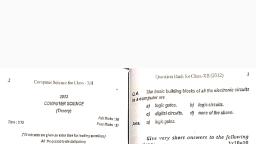Page 1 :
VIVA QUESTIONS, , II CS PUC PRACTICAL EXAMINATION, , CHAPTER 4 DATA STRUCTURES, 1. Define traversing an array., ANS : The processing of accessing each element exactly once to perform some operation is called, traversing., 2. Define searching., ANS : The process of finding the location of a data element in the given collection of data elements is called, as searching., 3. Define sorting., ANS : The process of arrangement of data elements in ascending or descending order is called sorting., 4. Define inserting., ANS : The process of adding a new element into the given collection of data elements is called insertion., 5. Define deleting., ANS : The process of removing an existing data element from the given collection of data elements is called, deletion., 6. What is an array?, ANS : An array is an ordered collection of elements of same data type that share common name., CHAPTER 6 BASIC CONCEPTS OF OOP, , 1. . Mention any three High level languages that follow the OOP., ANS:, •, , Simula, the first object-oriented programming language., , •, , Java., , •, , Python., , •, , Ruby., , •, , C++, , 2. characteristics /features/ basic concepts of OOP., ANS :, Objects : An object is a collection of data members and associated member functions., Classes: A class is a collection of objects that have identical properties, common behavior and shared, relationship., , BGS Pre University College Mahalakshmipuram, , Page 1
Page 2 :
VIVA QUESTIONS, , II CS PUC PRACTICAL EXAMINATION, , Data Abstraction: Data Abstraction refers to the process of representing essential features without, including background details or explanations., Data Encapsulation:, encapsulation., , The wrapping of data and functions into a single unit (class) is called data, , Inheritance: Inheritance is the process by which one object can acquire and use the properties of another, object., Polymorphism: The ability of an operator and function to take multiple forms is known as Polymorphism., Dynamic binding: Dynamic binding is the process of linking the procedure call to a specific sequence of, code or function at run time or during the execution of the program., Message Passing: A message for an object is request for execution of procedure., , CHAPTER 7 CLASSES AND OBJECTS, , 1. . What does the class definition specify?, ANS: A class definition is a process of naming a class and data variables, and interface operation of the, class., 2. . What does the class declaration specify?, ANS: A class declaration specifies the representation of objects of the class and set of operations that can, be applied to such objects., 3. Which is the default access specifier?, ANS: private, 4. Which operator is used to access members of a class?, ANS: (::) scope resolution operator., 5. Which type of data members can be accessed outside the class?, ANS: Public members, 6. What is the use/significance of scope resolution operator?, ANS: To define member function outside the class declaration., 7. What is an array of objects?, ANS: Collection of objects of same class (type)., 8. Can an array be a member of a class?, ANS: Yes, BGS Pre University College Mahalakshmipuram, , Page 2
Page 3 :
VIVA QUESTIONS, , II CS PUC PRACTICAL EXAMINATION, , 9. What are data members?, ANS: The variables declared inside a class are known as data members., 10. What is the use of member-functions?, ANS: Member-functions are used to interact with data contained within user defined type., 11. What are access specifiers?, ANS: Every data member of a class is specified by three levels of access protection for hiding data and, function members internal to the class. They are Private , Public and Protected., 12. How do you access a member function of a class?, ANS: Using dot (.) operator, Syntax: ObjectName . memberFunctionName();, 13. What are class instances called as?, ANS: Objects, 14. Write the syntax to declare an object of a class., ANS: ClassName objectName;, , CHAPTER 8 - FUNCTION OVERLOADING AND MEMBER FUNCTIONS, , 1. What is inline function?, An Inline function is a special type of function in which the function call replaces the body of function,, instead of transferring the control to the function., 2. Write any one advantage of inline functions., ANS:, , 3. . What is the disadvantage of an inline function?, ANS:, , is needed., 4. What is a friend function?, ANS: A friend function is a non-member function of a class has the access permission to the private, member of the class., BGS Pre University College Mahalakshmipuram, , Page 3
Page 4 :
VIVA QUESTIONS, , II CS PUC PRACTICAL EXAMINATION, , 5. What is function overloading?, ANS: Function Overloading means two or more functions have same name, but differ in the number of, arguments or data types of arguments., , CHAPTER 9 CONSTRUCTORS AND DESTRUCTORS, , 1. What is a constructor?, ANS: A Constructor is a special member function that is called automatically when an object is created., 2. Name the access specifier used to declare a constructor?, ANS: Public, 3. How many types of constructors are there?, ANS: Constructors are normally classified as follows:, o Default Constructors., o Parameterized Constructors, o Copy Constructors., 4. What is a default constructor?, ANS: A default constructor is a special member function which is invoked by the C++ compiler without any, argument for initializing the object of a class., 5. What is a zero argument constructor?, ANS: default constructor is called as zero argument constructors., 6. What is the drawback of default constructor?, ANS: It is not possible to initialize different objects with different initial values using default constructors., 7. What is a parameterized constructor?, ANS: A constructor that takes one or more arguments is called parameterized constructor., 8. Name any one method to invoke parameterized constructors., ANS:, , o Implicit Call, o Explicit Call, o Initialization at the time of declaration with “ = “ operator., , 9. What is a copy constructor?, ANS: Copy constructor is a parameterized constructor using one object can be copied to another object., BGS Pre University College Mahalakshmipuram, , Page 4
Page 5 :
VIVA QUESTIONS, , II CS PUC PRACTICAL EXAMINATION, , 10. What is a destructor?, ANS: A destructor is special member function that is executed when an object of that class is destroyed., 11. Which operator is used with destructor?, ANS: tilde (~)., , CHAPTER 10- INHERITANCE, , 1. What is inheritance?, ANS: Inheritance is the capability of one class to inherit properties from another class., 2. What is a base class?, ANS: Base Class is the class whose properties are inherited by another class. It is also called Super class., 3. What is derived class?, ANS: Derived Class is the class that inherits the properties from base class. It is also called Sub class., 4. Give any one advantage of inheritance?, ANS: Reusing existing code, 5. What is singe level inheritance?, ANS: Single Inheritance is the process of creating a new class from existing class base class., 6. What is multilevel inheritance?, ANS: Derivation of a class from another derived class is called multilevel inheritance., 7. What is hierarchical inheritance?, ANS: If a number of classes are derived from a single base class, it is called as hierarchical inheritance., 8. What is hybrid inheritance?, ANS: Hybrid Inheritance is combination of Hierarchical and multilevel inheritance., 9. What is multiple inheritance?, ANS: A class can be derived from more than one base calss is known as multiple inheritance., 11. What is visibility mode?, ANS: It specifies the availability of a class members in other classes., 12. What is a super class?, ANS: Base Class or Super class is the class whose properties are inherited by another class., 13. What is a subclass?, ANS: Derived Class or Sub class is the class that inherits the properties from base class., BGS Pre University College Mahalakshmipuram, , Page 5
Page 6 :
VIVA QUESTIONS, , II CS PUC PRACTICAL EXAMINATION, , 14. Write any two advantages of inheritance., ANS: Reusing existing code, o Faster development time, o Easy to maintain, CHAPTER 11 POINTERS, , 1. What do you mean by a pointer? (K), ANS: A pointer is a variable that holds a memory address of another variable., 2. Give any one advantage of pointer?, ANS: Pointers save memory space., 3. Give the declaration of a pointer?, ANS:, , Syntax:, , Data_Type * Ptr_Variablename;, , Example :, , int * iptr;, , 4. Which is address-of operator?, ANS: ‘&’ is the address operator and it represents address of the variable., 5. Which is the pointer operator? (K), ANS: (Indirection operator) ‘ * ‘., 6. How do you initialize pointer? (K), ANS: Syntax:, Example:, , PointerVariable = & variable;, iptr = #, , 7. What is static memory allocation?, ANS: Allocating memory during the compilation of the program., 8. What is dynamic memory allocation?, ANS: Allocating memory during the execution of the program or at run time., 11. What is the use of new operator in C++?, ANS: ‘new’ operator is an operator used for allocating memory during the execution of the program or at, run time., 12. What is the use of delete operator in C++?, ANS: The ‘delete’ operator is used to destroy the variables space which has been created by using the ‘new’, operator dynamically., 12. What is the other name for pointer operator?, ANS: Indirection operator., BGS Pre University College Mahalakshmipuram, , Page 6
Page 7 :
VIVA QUESTIONS, , II CS PUC PRACTICAL EXAMINATION, , 15. What does a pointer variable store?, ANS: It holds a memory address of another variable., , CHAPTER 17 WEB DESIGNING, , 1. What is HTML?, ANS: Hypertext Markup Language, a standardized system for tagging text files to achieve font, colour,, graphic, and hyperlink effects on World Wide Web pages., 2. Expand HTML., ANS: Hypertext Markup Language, 3. Write any one text formatting tag., ANS: <u> , <i> , <b>, 4. What is the extension name for hypertext markup language?, ANS: .html or .htm, 10. Expand XML., ANS: Extensible Markup Language (XML), 12. Expand DHTML., ANS: Dynamic Hypertext Markup Language, 15. What is hypertext markup language? Give its extension name., ANS: Hypertext Markup Language, a standardized system for tagging text files to achieve font, colour,, graphic, and hyperlink effects on World Wide Web pages., Extention name is .html or .htm, 16. Write any two text formatting tags., ANS: <u> , <i> , <b>, 17. Explain any two resizing text tags., <font> , <small> , <big>, , BGS Pre University College Mahalakshmipuram, , Page 7
Page 8 :
VIVA QUESTIONS, , II CS PUC PRACTICAL EXAMINATION, , TAGS AND MEANING, <HTML> ..... </HTML>, , Hyper Text Markup Language, , <HEAD> .....</HEAD>, , The head, or prologue, of the HTML document, , <BODY> ..... </BODY>, , All the other content in the HTML document, , <TITLE> ..... </TITLE>, , The title of the document, , <P> </P>, , Paragraph, , <BR>, , Line Break, , <LI> </LI>, , List, , <OL> </OL>, , Organized List ("LI" before each list item), , <UL> </UL>, , Unorganized List ("LI" before each list item), , <IMG SRC= >, , Image Source, , <B> </B>, , Bold, , <I> </I>, , Italic, , <U> </U>, , UnderLine, , <table>, <TR>, <TD></TD>, </TR>, </Table>, <form> </form>, , Start Table, Table Row, Table Data, End Data, End Row, Ends Table., Create an HTML form, Input field where the user can enter data, , <input>, , •, •, , <input type="button">, <input type="checkbox">, , <font> </font>, , Specify the font face, font size, and color of text, , <center></center>, , Center-align text, , BGS Pre University College Mahalakshmipuram, , Page 8
Page 9 :
VIVA QUESTIONS, , II CS PUC PRACTICAL EXAMINATION, , SQL – Structured Query Language, 1. Write anyone RDBMS software., Ans. Oracle, MySQL, 2. Expand SQL., Ans. Structured Query Language., 3. Expand DDL., Ans. Data Definition Language., 4. What is DDL?, Ans. Data Definition Language is used to define the physical characteristics of the table like field name,, its data type, size etc., 5. Expand DML., Ans. Data Manipulation Language., 6. What is DML?, Ans. Data Manipulation Language is used to manipulate the data i.e. add, remove or modify the data in a, table., 7. Name a Data Query Language command., Ans. SELECT command is a Data Query Language Command., 8. What are constraints?, Ans. Constraints are the restrictions enforced on the contents of the table., 9. What is the use of NOT NULL constraint?, Ans. It ensures that the column cannot have NULL value. 2, 10. What is the use of unique key?, Ans. It ensures that all the values in the column are different., 11. Write any two single-row built-in functions in SQL., Ans. LOWER( ) , UPPER( ), SQRT( ) , MOD( ), 12. Write any two group built-in functions in SQL., Ans. MAX( ), MIN( ), SUM( ), AVG( ), , BGS Pre University College Mahalakshmipuram, , Page 9












































